Meet The Hazmats
A Pennsylvania-based quilting group established in 1989.
Quilts are considered folk art—their craft involves creating beautifully functional objects made from scraps of others. A pattern is used to begin, but the combination of fabric colors, textures, and sewing techniques employed is unique to the maker. In this way, quilting groups are a bit like their handiwork—lovingly gathered disparate pieces joined to create a whole, a shared outcome in mind. And they keep themselves in stitches along the way.
My formal introduction to the world of pieced, appliquéd, and embroidered began on a rainy Sunday this past October when I drove by a historical mill at the edge of a nearby New Jersey river town. A sign advertised a quilt show within, so I shortly found myself wandering two expansive floors of gorgeous, colorful quilts hung from exposed beams, the diffused light from deep-silled cylinder glass windows reflecting upon the embedded geometric shapes of fabric.
There were so many impressive creations—from traditional patchwork stars to custom garden scenes—but one quilt, in particular, stopped me in my tracks. It featured an incredibly detailed portrait of twelve cheerful women in a circle, smiling down as if welcoming the viewer back to consciousness after a heady faint or delightful afternoon nap.
The artist credited was named Gina, and the sign pinned next to it read:
This raw-edge collage quilt shows my Wednesday afternoon quilting friends—the Hazmats. The group started in the 1980s and members have cycled in and out over the years. It was a joy to create this snapshot of our time together. Fabrics from most members are included in the quilt.
Those faces, that history, the group name. I absolutely had to know more about these women! So I emailed the organization that hosted the show, and they put me in touch with Gina. A few weeks later, I was perched on a cozy chair in Gina’s living room with a brownie a-la-mode in hand, chatting with six of the group’s current ten members—Cass, Gina, Linda, Kathy, Janet, and Penny—as they gesticulated with strung needles, folds of bright fabrics curled cat-like in their laps.
The group’s quirky name came about in 1993 when four of its six founding members—Annie, Pat, Joanne, and Judy—were on a road trip to Fayetteville, North Carolina for a quilting retreat. They kept seeing signs about hazardous material not being permitted in the tunnels and joked about their quilting fabric being hazardous. With that, the Hazmats (short for “hazardous materials”) were born. Among them, roles were naturally established—Pat became the historian of the crew, and Annie was the social butterfly and unofficial recruiter.
As group dynamics go, it was intriguing to see how later members stepped in to carry the mantles of those who came before. Sat in a semicircle around me, the ladies explained how they were inducted into The Hazmats, and it became clear that Gina is the new Pat and Penny is the new Annie.
Pat called their Wednesday gatherings, “The holy day of obligation.” The casual reverence of the assembly does feel a bit like gospel—the women shuffling in right on time, seating themselves comfortably, offering updates on their health and families as if they’re continuing a sentence after a short pause; Gina weaving among them serving drinks and dessert (it’s tradition for them to eat something sweet). The ladies said they’ve had fairly astounding luck when it comes to the compatibility of new Hazmats—largely due to the fact that they keep their numbers small; they’ve never had more than a dozen or so members. Janet calls them “A one-pie group.”
“Just because you have relatives or family, doesn’t mean you have something in common with them,” Cass said. “I think as you get older, your friends are more important to you because you have that commonality.”
I immediately felt endeared to the past Hazmat members through the stories of those surrounding me, which led me to consider how women protect and preserve their own stories, how they seek safety in community, and how they develop self-expression and build their legacies through art. The matter-of-fact tones with which they spoke their quilting origin stories belied their deeply personal reasons for finding solace in their stitches.
Gina, whose gorgeous quilt brought me to the group, has always gravitated toward portraiture and creations made with pieces of fabric related to a loved one. Her grandmother quilted and her mother was a painter—in fact, her quilted version of one of her mother’s paintings hangs beside it in her home’s entryway.
“I started quilting when I left the workforce, to have something to do,” Gina said. “After my dad passed, I wanted to do some in-memoriam things—the first quilt I made has fabric from my dad’s shirts on it. My second quilt was for my mom, with fabrics that reminded me of dad’s shirts, and then I got fabrics that reminded me of mom’s blouses.”
Before dreaming up her gorgeous 2021 rendering of the Hazmats, Gina created a portrait of Janet’s beloved 26-year-old parrot Kiwi, who passed away in 2017. The way Janet reverently held the small piece as I photographed it told me everything about their bond, and how the love they shared is commemorated in every fabric shade and stitch, thanks to Gina.
Janet’s introduction to the art was one of a somewhat supernatural nature. “My mother made a quilt and I’ve always admired it and I thought, ‘I will never make a quilt, I just wouldn’t be able to do it.’ Before she died she gave me that quilt, it had a stain on it. She said, ‘Janet, don’t worry about it.’ And after she died, the stain disappeared.”
“I just thought, ‘I’ll try something,’” Janet continued, holding a gorgeous vegetable quilt in her lap, which she’s been working on intermittently since 1994. “I saw a pattern and it was an appliqué quilt with a bunch of flowers on it. I did it and I thought, ‘I’ll never make another one.’ Guess what, I’ve made 40, 50, 60 quilts since then!”
“She started with the easiest thing she could make, appliqué!” Penny interjected, and laughter rang through the room.
“My kids were going to graduate and I wasn’t going to have those boys around,” Penny said, chiming in with her quilting origin story. “I’d been taking them to their games and activities and I thought, ‘I am going to have to find something to do or I am going to be lost.’”
“Another reason why I didn’t get Mother of the Year,” Cass muttered, setting off a chorus of chuckles.

“I came to quilting the year before they graduated,” Penny continued. “I didn’t know I’d like it, I was going to give it a try. My aunt sewed—she used to look at something and could envision exactly what you had to do to tailor and sew it. My grandmother quilted; I still have some of her quilts.”
After retiring from teaching public school for 35 years, Penny inquired about a position at a local sewing supply shop and worked there as a teacher for 16 years until the pandemic—that job is how she met and recruited many of the Hazmats members who’ve cycled through.
Linda, also a former teacher, found quilting in a roundabout way—she dabbled in sewing classes before becoming a therapeutic horseback riding instructor, and after back issues wouldn’t allow for equestrian work, she pursued quilting in earnest.
“My mom was a marvelous seamstress, but didn’t do any quilting,” Linda said as she pieced together hexagonal fabric shapes for an intricate design. “The first quilt I ever made was when my daughter was an infant—it was a pattern in Woman’s Day, an alphabet quilt. I made the blocks with all the letters, sewed it all together, and didn’t realize I had to quilt the front, the back, and the batting together. The first time I washed it, all the batting balled up.” A few sympathetic groans rose from the group. “I think I like quilting because I love playing with colors, and that’s what quilting is—it’s playing with colors and patterns and textures.”
Kathy’s sister is Judy, one of the group’s founding members. “I was an art major and I didn’t like teaching, so I went into working for the district courts as a clerk and sewed on the side,” Kathy explained as she pinned an idyllic farmhouse scene quilt. “My sister got me into quilting and I just loved it.”
“I always sewed,” Cass said. “We were really poor growing up, so we had to make our own curtains and a lot of our own clothes if we didn’t have hand-me-downs. I could sew and of course, every girl my age had to take home economics.” As she spoke she pulled pieces of fabric from her scrap bucket for a dots and squares lap quilt pattern called “Oh Happy Day.”
“My father died when I was six or seven,” Cass continued. “So when we moved out of the city [Philadelphia] there were six kids in a taxi cab, so you know we didn’t bring anything. My mom used to save all these scraps of material and put them in the attic and say, ‘One of these days I’m gonna make a quilt.’ Years went by. 40 years ago, I went up in her attic and said, ‘Mom, I’m gonna take some of this fabric.’”
Cass rummaged through the scraps and recognized kitchen curtains, her brother’s white shirt that he always wore with black chinos, her mother’s apron. She created a family portrait using the apron material as her mother’s dress, and fabric hand-picked by her sisters. “It is the ugliest quilt,” she said, smiling. “But everyone could pick out the fabric and say, ‘I remember this or that.’”
“I had an old sewing machine and moved into an apartment with my daughter after my divorce,” Cass said. “I had no money, and I had to make curtains for 12-foot ceilings. There was a guy down the street selling fabric for $1/yard, he told me how to make the pleats. I had a ski suit and no money to ski, so I traded the ski suit for a Singer sewing machine. It was an aqua blue Singer, I just gave it to my great niece.”
I was struck by the way that the craft endured through the generations—how these women held fast to the traditions of their mothers, aunts, and grandmothers. How they gathered to nurture their pasts and presents and passed their futures on through their creations, many of which take years of work.
“A lot of people don’t understand how much time goes into a quilt,” said Janet. “The fabric alone is expensive now, you buy fabric and cut it all up in pieces and put it back together. People who don’t quilt don’t understand why it costs so much for a handmade quilt.”
“If someone ever gives you a quilt, don’t tell them, ‘Thank you for the blanket,’” said Penny, setting off knowing laughter among the women.
“What I’ve enjoyed about the quilts I’ve given to grandkids, nephews, and now grandnephews is I’ve sent them a quilt and said, ‘Don’t hang it on the wall, please, use it.’” Janet said. “When I went to see my sister’s kids, they got out their quilts and they made tents out of them. They have holes in them, they’re faded, they’ve been washed. They’ve been loved. That’s what I love about it.”

During COVID, the group continued their weekly gatherings on Zoom; that’s how Gina compiled the selfies needed for each portrait in her quilt. I gathered the women for a photo beneath Gina’s rendering and wondered who would inherit it and continue to tell and build upon the story of The Hazmats.
“As the Hazmats members change over time, I hope memories and traditions will continue to be passed down,” Gina said. “Right now, I am the youngest member and cherish all the life and love that these ladies have to offer. …It is very common that when a quilter passes that her fabrics, machines, and quilts in progress are offered to her quilting friends or a local guild. We hope that someone else will find joy and use of those patterns and items that were chosen with such care and that the heritage lives on. For now, I can’t imagine parting with this quilt that I enjoy every day, but I am confident that it will stay with someone who loves the art and community of quilting.”

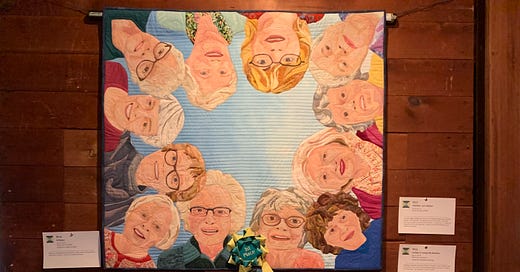


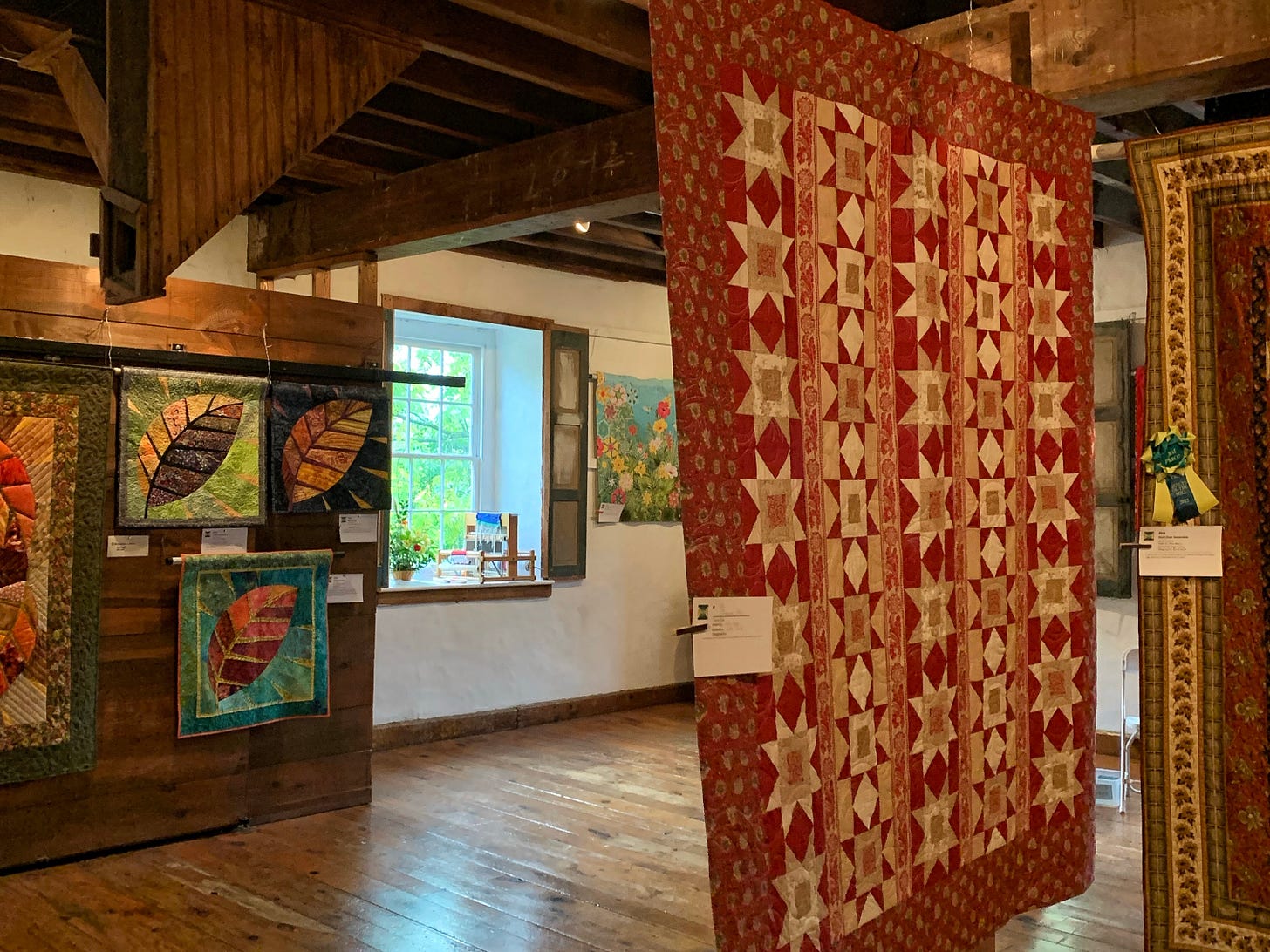
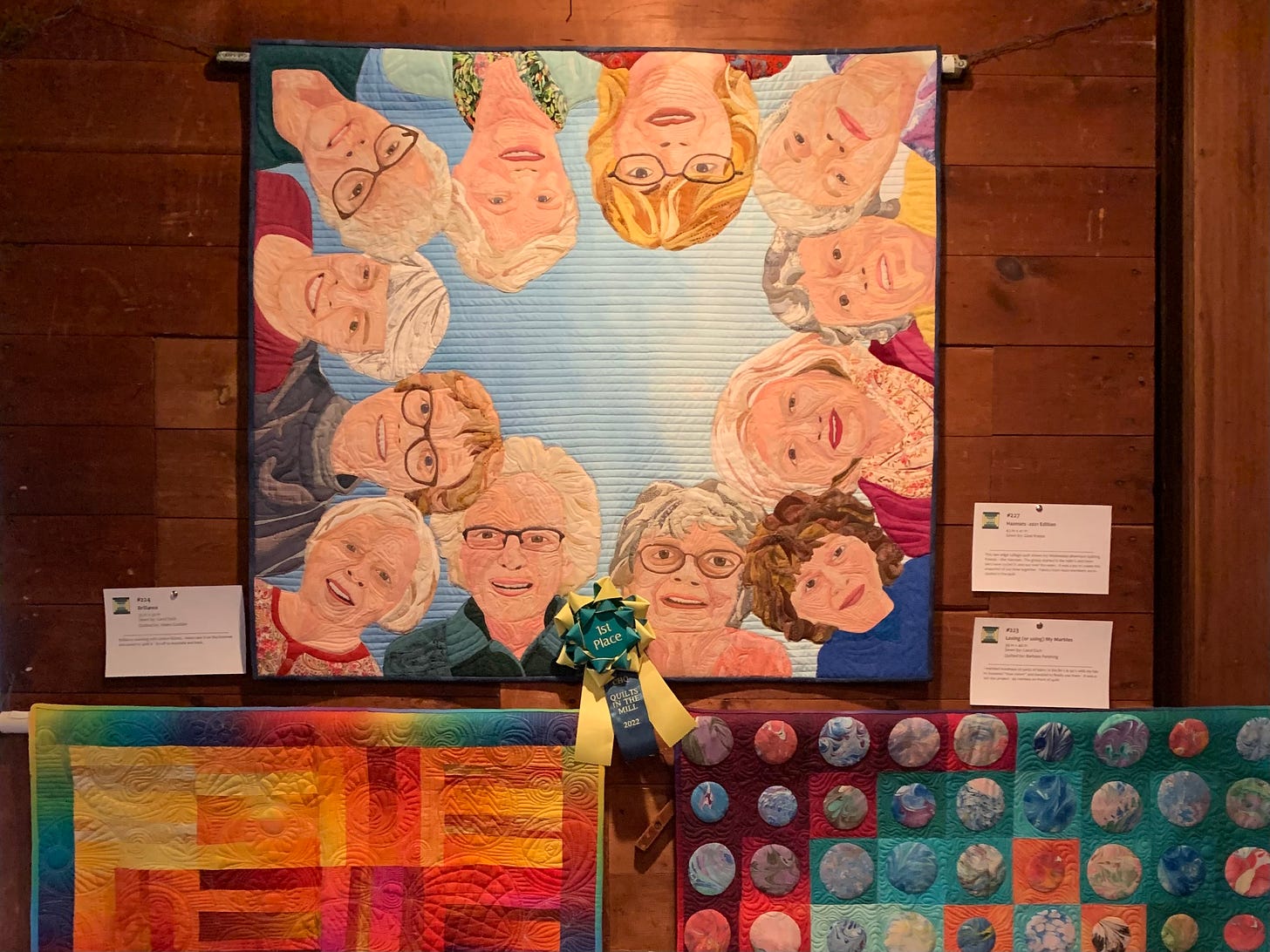
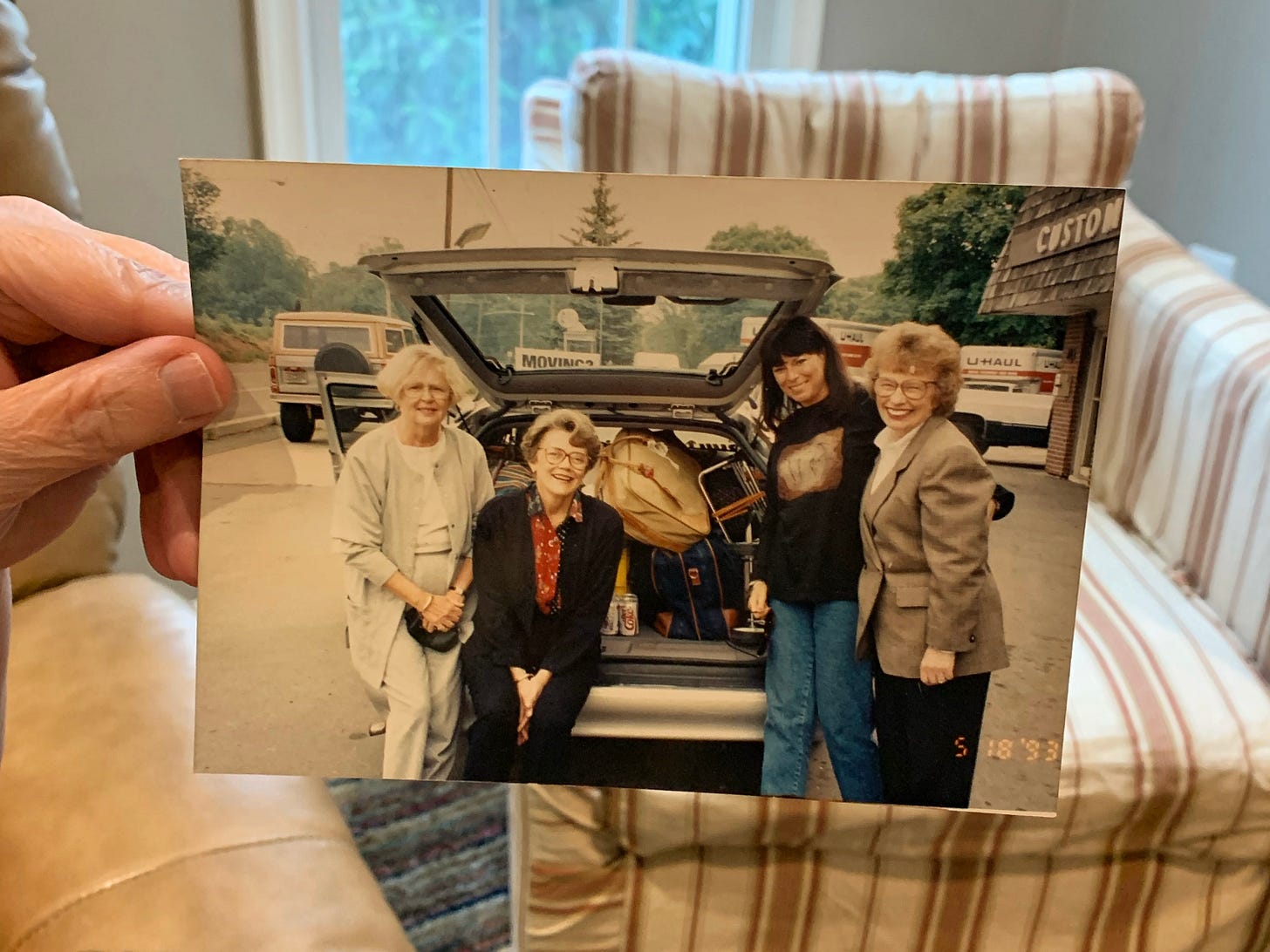
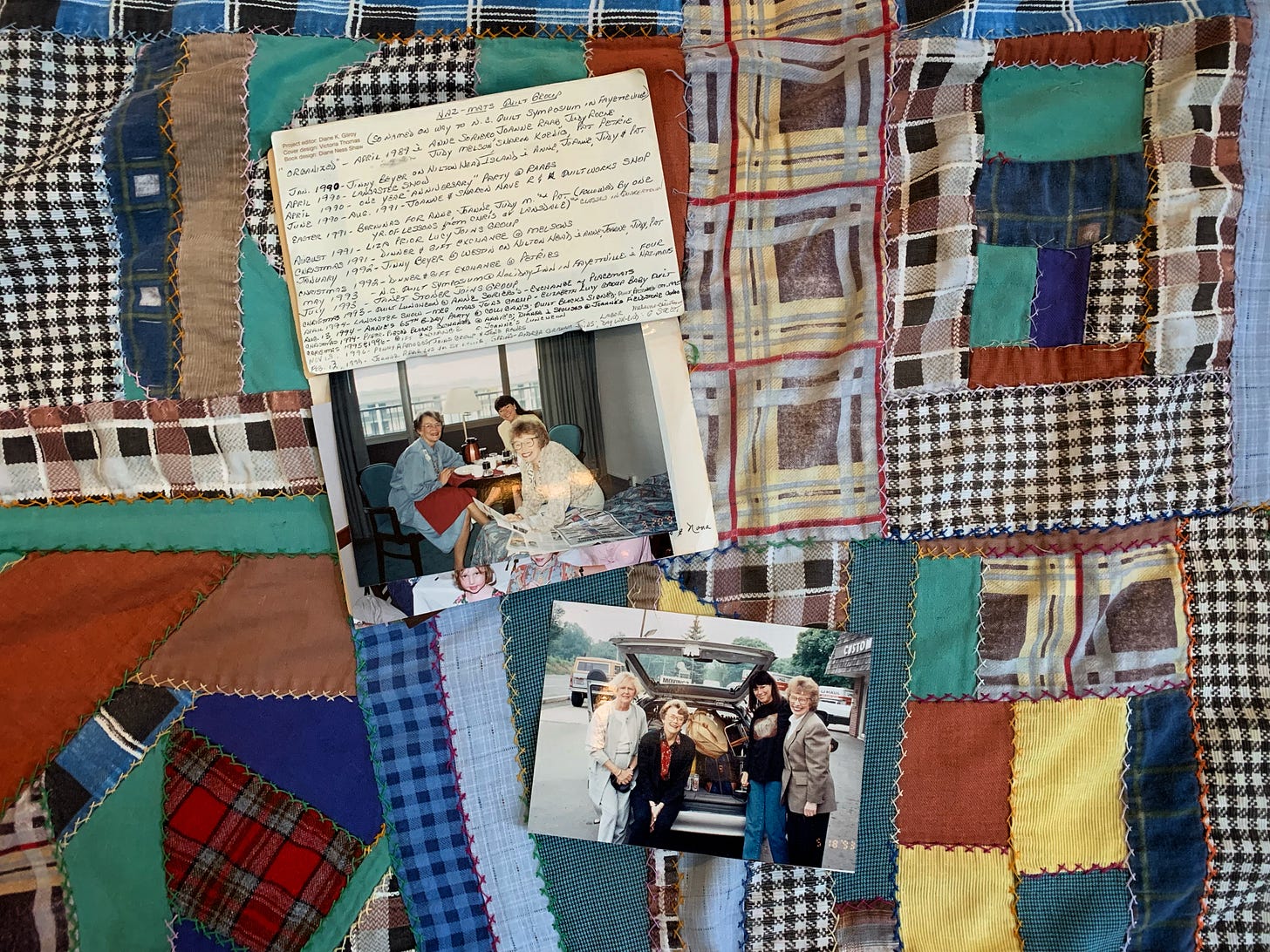

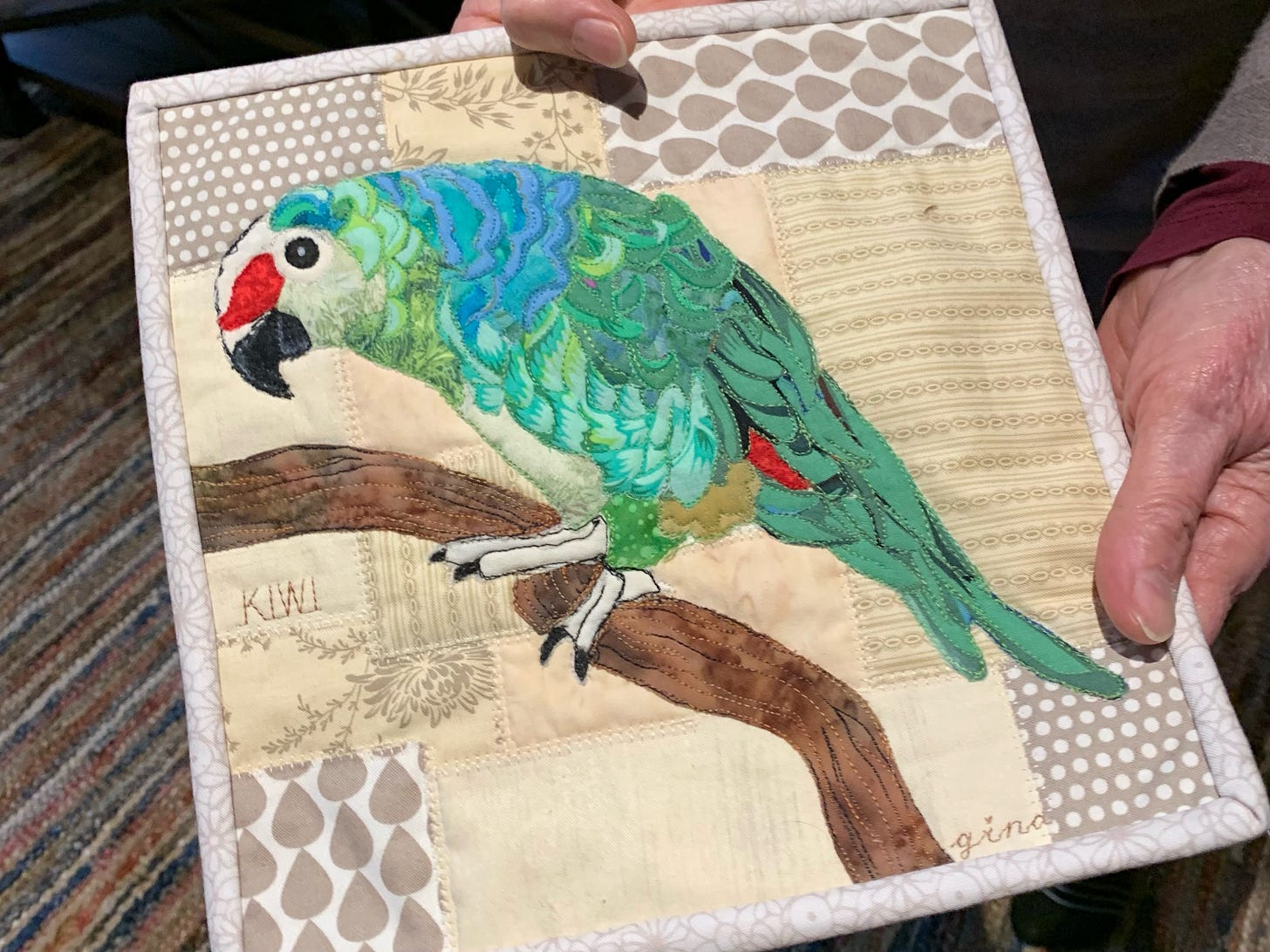
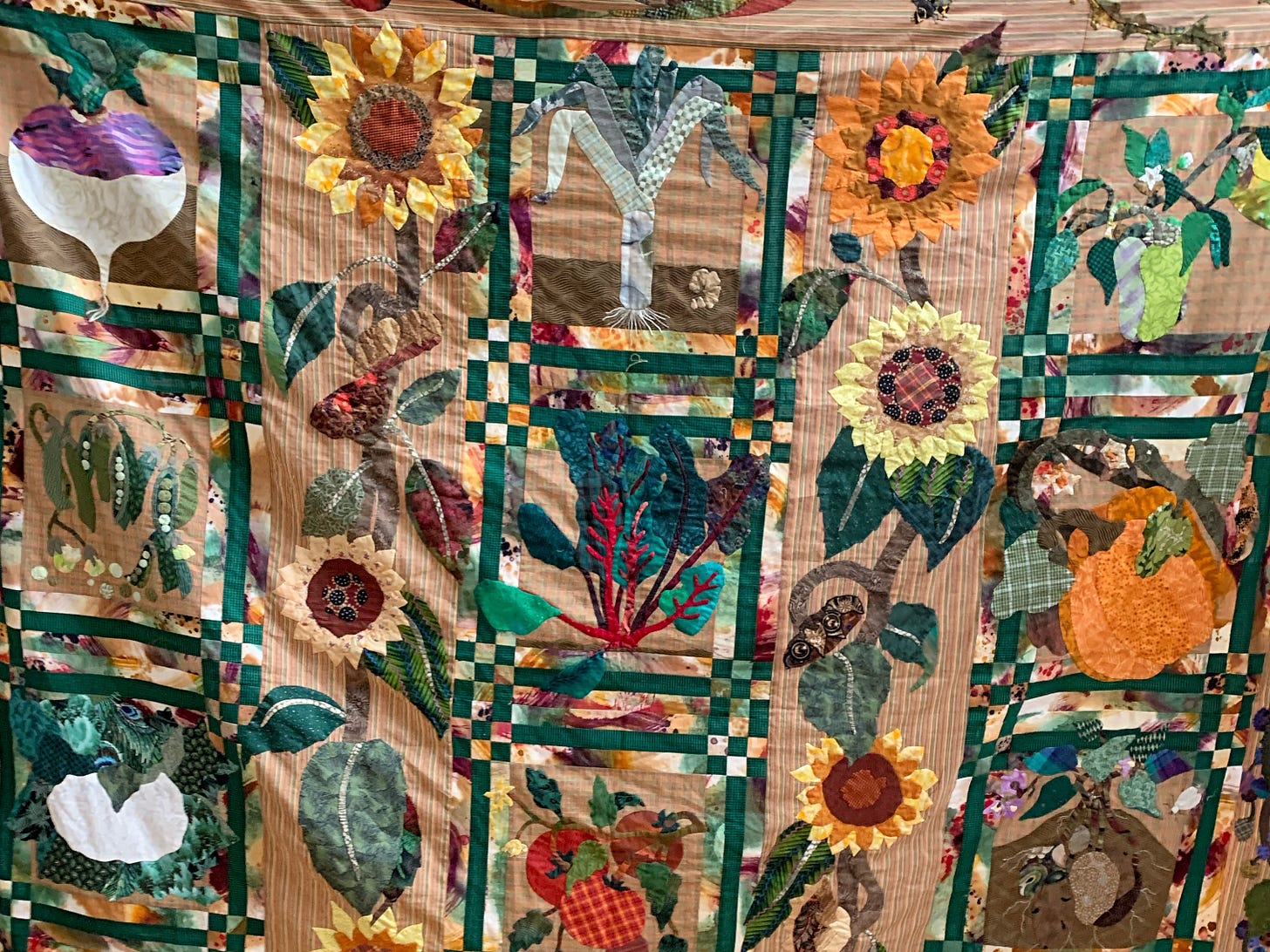
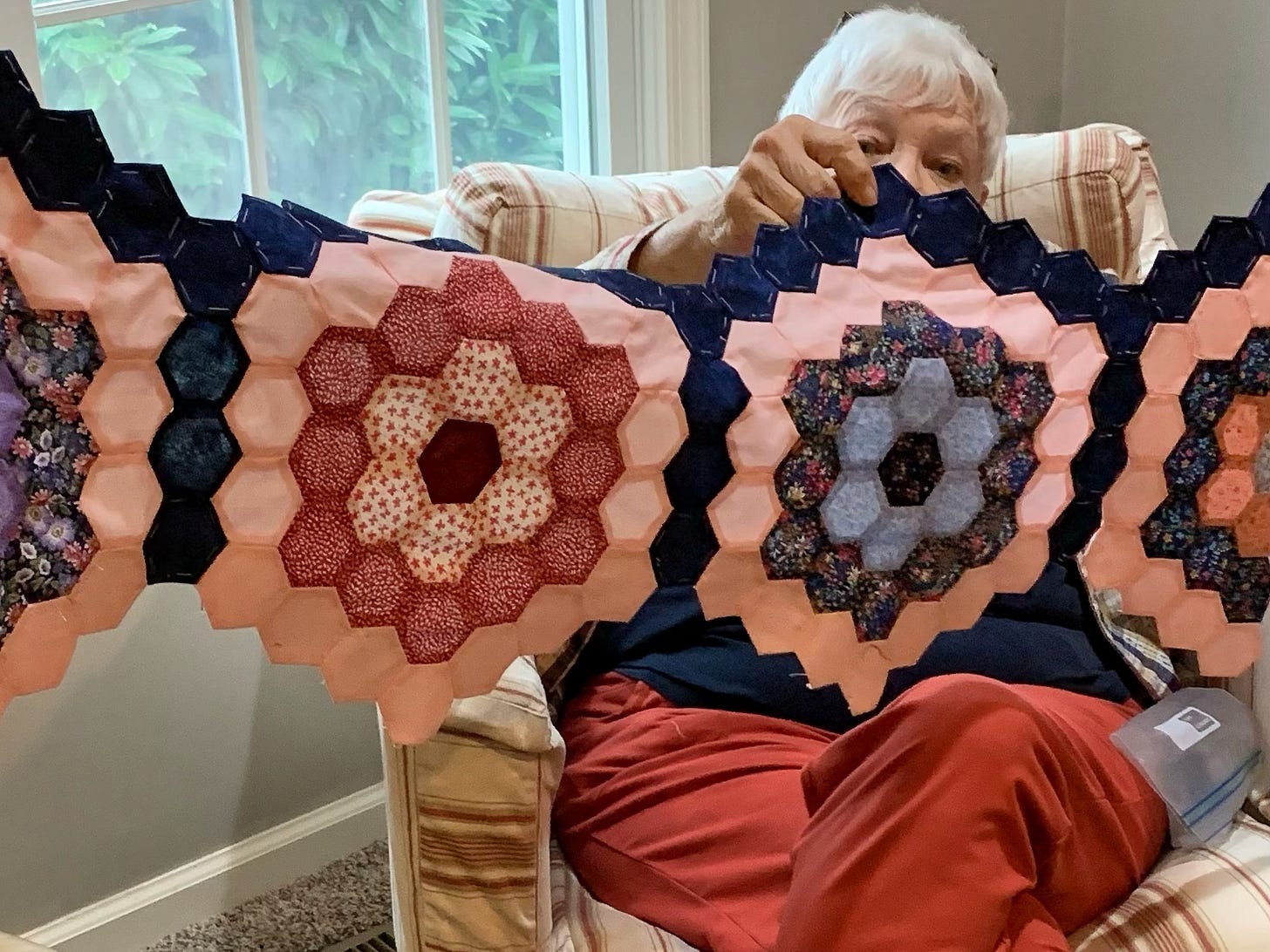
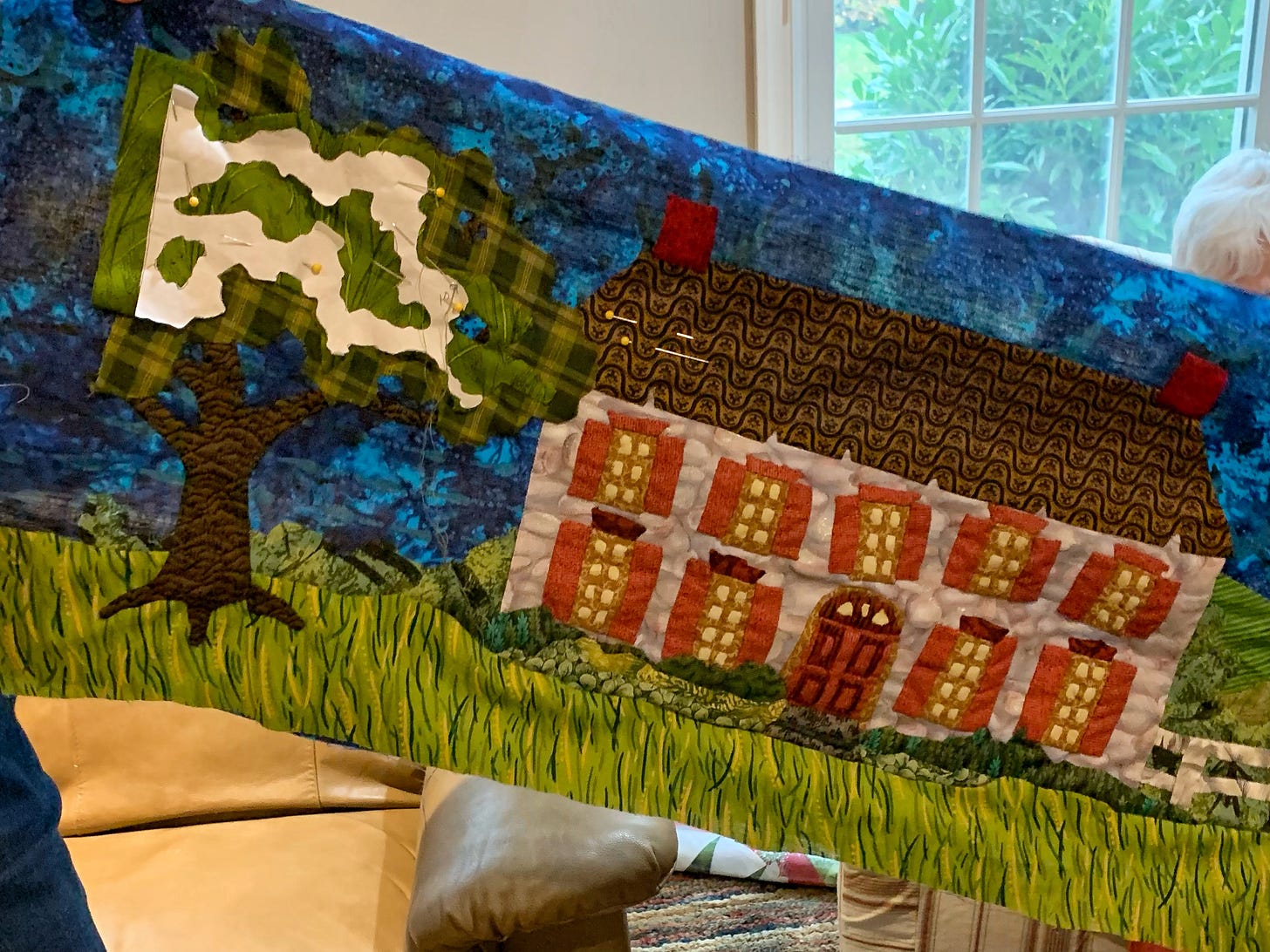
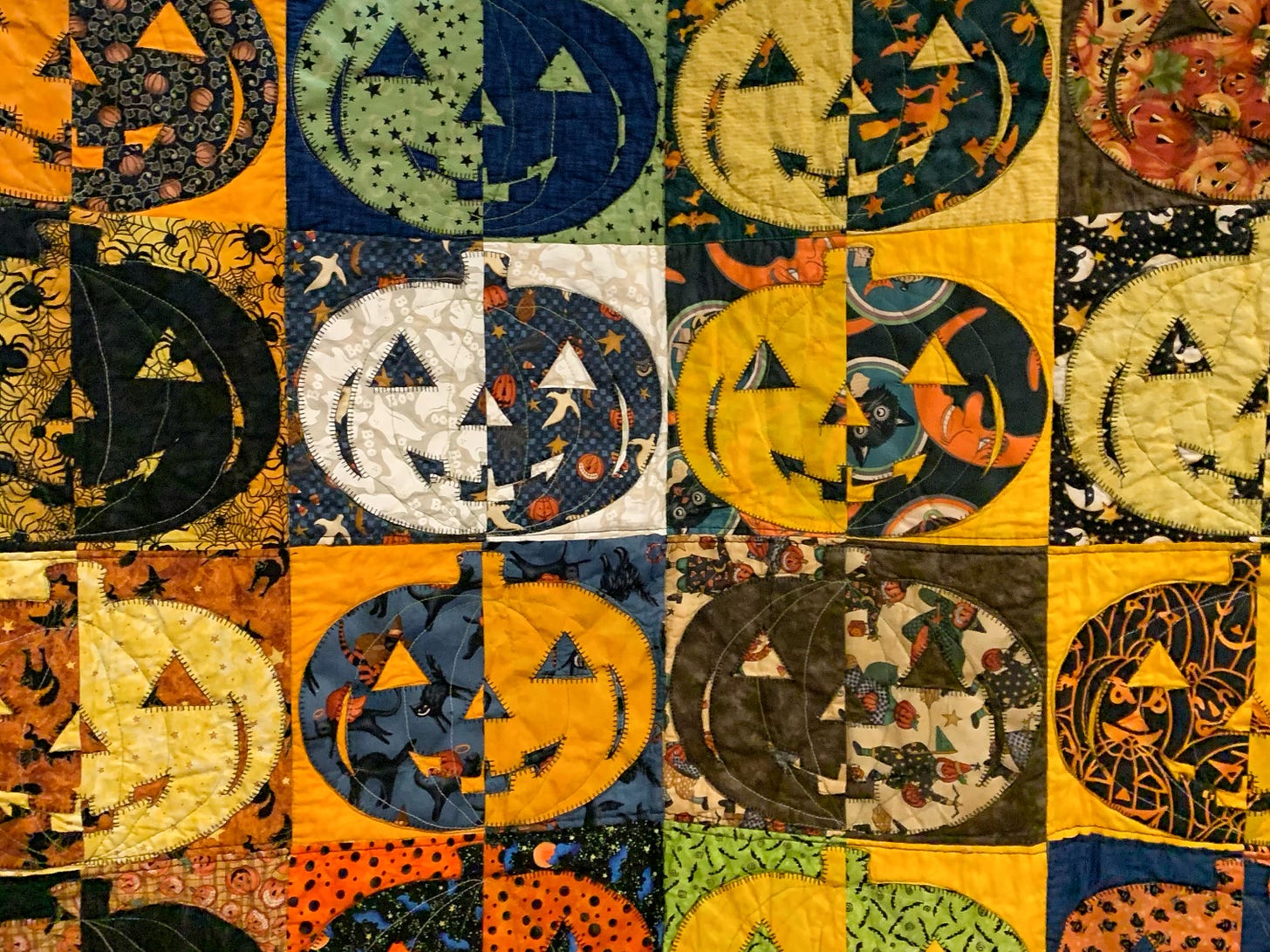
Pat was my Nana. Your writing brought happy tears to my eyes. You painted such a beautiful picture of the community these ladies share. While I don’t know all of them personally I have heard their names in stories by her many times and even remember curling up in her sunroom admiring and studying their handiwork on days when she hosted the quilting group. It is ironic that last night I was sitting at my dining room table as a grown woman playing with quilt blocks she gave me as a child, trying to work out a plan for a quilt I’d like to make with her machine that I’ve inherited. The lessons she taught me in sewing and in life are invaluable. Thank you so much for paying tribute to decades of hard work, friendship, and this beautiful craft. - Megan
Absolutely wonderful story. Please keep roaming around finding quilters and knitters to interview! The photos were gorgeous!